One of the key factors in business success is leverage. Microsoft Advertising Intelligence allows you to leverage true history and forecast data. This means your keyword efforts are based on actual customer activity. You get key performance indicators (KPI) to track performance.
The full name of this tool is Microsoft Advertising Intelligence. It is designed as a research and optimization tool that works with Microsoft Office Excel 2007, providing keyword expansion, pricing, KPI data and research. What this means for the business person is that you can make the most of your marketing investment. You’ll need to uninstall the earlier versions of adCenter Add-in for Excel. Of course, you should have Microsoft Office Excel 2007 installed. Be sure Excel is closed when you go through the Ad Intelligence install process.
With Ad Intelligence you can work with lists of suggested keywords, and develop your strategy for keywords using MSN and Bing query information. The details include volume, relevance, demographic and geographic tracking as well as cost history. This data helps you fine tune your bid strategy because you use actual pricing information and data that is specific to keywords. You get information on clicks, impressions, cost-per-click and position.
As product information for Ad Intelligence states, “Search activity reflects real time consumer behavior which helps determine the best planning approach for your online and offline campaigns. This ensures you are talking to your consumers with the right message, at the right time in the right place, to build truly integrated campaigns.”
Planning for Success
It’s tempting to get into the online marketing business because it seems the “hot” thing to do. But if you want to increase the chances of success you should devote some time to planning first. Microsoft Advertising Intelligence is designed to assist you in that planning process. For example, your working campaigns will be constructed on reliable information, data that allows you to make good decisions.
Ad Intelligence means using keyword search tools built into the Excel program as well as developing keyword lists based on actual behavior and trends. Data you can use includes relevant rankings that will help you understand how this will add value to the effort. You will be able to use your business budget on campaigns that actually work!
Features that will help your efforts succeed include a keyword wizard that lets you pull keywords out of an Excel list or from a specific URL. You can then expand your keyword list based on bidding association, similarity of categories or keyword phrases that contain the single keyword. You can move a detailed report containing estimated search volume, ad position, click-through, click cost for a specific range of dates etc.
Search buzz focuses on top-category keywords, with almost two dozen core categories available. There are dozens upon dozens of subcategories. If you are familiar with the usefulness of “spiky” numbers you’ll find that Ad Intelligence uses the above-mentioned categories but focuses on spiky keywords. Features include spike start and end dates as well as spiky index. One of the key features allows you to set your information to all verticals so you can uncover the leading spiky keywords or top search queries.
There’s More!
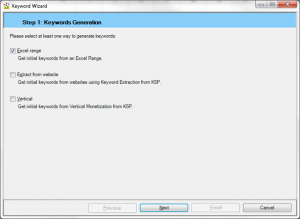 Microsoft Advertising Intelligence offers keyword-focused tools such as extraction that is based on input URL. You will be able to set the maximum number of keywords up to 100. It even allows you to establish a minimum relevancy so you can tailor your confidence level. If you are not sure of the efficiency of a certain keyword the tool has keyword suggestion to help you. Suggestions are based on such details as long-tail keywords containing the core keyword and on advertiser behavior.
Microsoft Advertising Intelligence offers keyword-focused tools such as extraction that is based on input URL. You will be able to set the maximum number of keywords up to 100. It even allows you to establish a minimum relevancy so you can tailor your confidence level. If you are not sure of the efficiency of a certain keyword the tool has keyword suggestion to help you. Suggestions are based on such details as long-tail keywords containing the core keyword and on advertiser behavior.
Other features include:
One of the nice tools available in Ad Intelligence is keyword normalization. This means that the software will find and flag duplicates in an advertising group. The feature might select a keyword if it has extraneous characters or if capitalization is a bit different. This process takes place automatically and will save the use a lot of time. You don’t have to manually manage variations of the same keyword.
Extraneous characters might be quotation marks, hyphens, asterisks, parentheses, brackets and many other common symbols. Extraneous words such as “a” and “an” may trigger normalization as well.
The advertiser can remove duplicates or remove the original. With the automatic task in Ad Intelligence and some careful editing by the advertiser this feature will mean more search queries match chosen keywords. Advertising return should be increased with this fine-tuning process.
This group of tools is designed to help advertisers improve their online advertising results through accurate modeling. Business owners will be able to more correctly predict intent of the user because of the specific data based on keyword and phrase selection. This can be an awesome tool in the online commercial world. Why? Because the way people search is determined by geography, demographics, age, gender and other factors.
Keyword and search characteristics provide a nice overview of the target audience. An advertiser use Ad Intelligence is able to learn more about a user’s intent and discover a doorway into a social network that this user is part of.

Let’s play a game. Let’s pretend you are the webmaster of www.reallyawesomeflannelrobes.com and you have a supply of awesome flannel robes. How do you plan on selling your flannel robes? I guess you’d want to do some SEO, right? So you optimize your website for the phrase “buy flannel robe”. You hire some hot-shot SEO firm (or maybe you do it yourself!) and they do a great job! After a short while, you’re kicking butt on all your primary keywords. You’re even ranking #1 for your best keyword, “buy flannel robe!”.
…almost.
Because when you do a Google Search for “buy flannel robe”, what do you find listed above your #1 ranking? A little box that says “Shopping results for ‘buy flannel robe'” and a listing of products from Amazon.com, L.L. Bean, Plow & Hearth, and Vermont Country Store. What’s more, these listings have prices, pictures, and a description of the item. Worst of all, these listings have reduced your CTR to a dismal percentage for your coveted #1 ranking. What’s going on here?
Back in mid-2007, Google made a major change in their search algorithm called Universal Results. This update integrated Google’s regular search functions with other pieces of Google’s search database, most prominently images, videos, and yes, shopping results. When a user searched for certain keywords, Google began returning results from other realms of its search database if it deemed them to be relevant. These integrated results could appear organically, or they could be tripped by certain flagged words. The words ‘pictures’ or ‘photos’in conjuction with any other search topic are highly likely to return results from Google Images. The words ‘video’ or ‘clip’ or ‘movie trailer’ in conjunction with any topic is likely to return results from Google Videos. And yes, the words ‘buy’, ‘purchase’, or ‘cheap’ in conjunction with any topics are likely to return results from Google Shopping (formerly Froogle).
So that’s it. You’re doomed right?
Not necessarily.
Let’s take a look at these results. clicking on the first shopping result in our flannel robe example brings us directly to the amazon.com listing for the State O’ Maine Men’s Big and Tall Plaid flannel robe. This makes something immediately clear. Google Shopping is not a vendor, but a comparison shopping database. When you search for something in Google Shopping, the database evaluates its listed products and returns results that, based on an algorithm, have been determined to be the most relevant. So where does it get this knowledge of listed items?
The answer is Google Base. Google Base is an archive of information submitted by users from across the web. Almost any kind of data can be submitted in almost any kind of format. The most widely used portion of the Google Base platform, however, is the Google Merchant Center. In the Google Merchant Center, vendors like Amazon (and you too!) can submit a data feed of product listings that comes directly off their websites. The data feed keeps Google Merchant Center constantly updated on what products are on your website and the Google Merchant Center powers Google Product Search (Shopping).
So what about this data feed that comes off your website, hmm? This feed is a service provided free by many popular e-commerce platforms or as a paid service from independent developers. You can think of it as a kind of RSS feed for Google Merchant Center to ‘read’ your products. In addition to the Merchant Center, you can submit this feed to a variety of comparison shopping engines like Shopzilla, Nextag, Bizrate or Price Grabber. All of these comparison shopping engines use your data feed to power their search results. If your data feed has provided information that the comparison shopping engine thinks makes your product highly relevant to a product search query, your product will be listed first. So how do we make sure that our data feed is providing the right type of information? This process is called Data Feed Optimization, or (DFO). It is also commonly referred to as shopping feed management. DFO is the process of ensuring that your data feed is being comprehended by a comparison shopping engine like Google Product Search to the greatest of its potential and serving up your products as search results when they are most relevant.
So how do you do this?
Basic data feed optimization can be split up into a few specific partitions. When embarking a data feed management campaign, the first thing you should do is establish some kind of evaluation metics. Whether you use click counters on your website, with the comparison shopping engine or with a third party doesn’t really matter; you just need some way to evaluate the results of your actions. The nextand easiest thing you can do is make sure your tax and shipping costs are updated for every product you list. If you don’t believe me on the importance of this, do a Google Product Search for ‘digital camera’ and click on the first link. You’ll see a list of vendors where you can buy that exact camera (at the time of this writing, it’s a Canon Powershot SX20). The prices seem to be pretty uniform across the board, and it becomes immediately obvious that you can get this camera with free shipping (several vendors are offering it). Now look down at Sears. Sears has this camera for sale. Does it offer free shipping? Maybe. You can’t tell, however, because Sears hasn’t updated its data feed to ensure its shipping and tax info are being listed. What do you suppose the CTR on that listing is? That’s a rhetorical question, because off course it’s just about nil.
In DFO terms, accurate and updated tax and shipping info are equivalent to meta-tags in SEO. It’s a super easy fix that there’s absolutely no excuse to get wrong. Seeing shipping info compels a consumer to click in the same way a meta-description with a powerful call to action does.
Also east to fix are the listing title and listing description. This is an area of DFO that has no hard and fast rules; it’s best to just play around with a few different combinations until you find something that fits. All DFO experts agree, however, that the listing title should be optimized with both consumers AND the Google Product Search algorithm in mind. What is the primary keyword associated with your product? What IS your product? Does it have a significant brand name? At the time of this posting, I made a search for “calvin Klein Dress Shirt” in Google Product Search. The #1, #3, and #6 results all used the phrase “Calvin Klein Dress Shirt” in the listing title. None of those listings were calvin Klein’s product website. Calin Klein’s highest listing for its own product on its own website was #8. This listing did NOT use the phrase “Calvin Klein Dress Shirt”. While not being decisive empirical evidence, these results strongly indicate that the usage of the search keyword in the listing title can affect ranking. DFO industry experts recommend trying a variety of title combinations and evaluating the performance of each. Some of the ones you can try from our example are:
[keyword][brand][feature]—ex.: Men’s Dress Shirt, Calvin Klein White
[brand][feature][keyword]—ex.:Calvin Klein White Men’s Dress Shirt
[brand][keyword]—ex.:Calvin Klein Men’s Dress Shirt
[feature][keyword]—ex.:White Men’s Dress Shirt
Now that the easy stuff is out of the way, we can tackle the real meat of DFO: feed mapping. The goal of feed mapping to provide information in your feed that categorizes every single product in your product portfolio into a corresponding category on a comparison shopping engine based on attributes. When I said every single, I meant every single. You should aim for a 100% listing rate on your products in the CSE’s. Every product you DON’T get listed might be your best-selling, high-margin, high competition product you were anticipating major sales on. This is easily checked by comparing the number of listings on your website and the number of your products listings showing up in the shopping engine (should be available from the marchant login dashboard). When you submit your data feed to say, Google Merchant Center, you’ll notice that you have options for setting your attributes. These attributes are split up into 4 categories, being required, recommended, optional and custom. You want to use them ALL. You need to categorize every single product in your product portfolio and map it with the attributes available on your comparison shopping engine. Google Product Search is not the only CSE you need to worry about and each website (e.g. Shopzilla, NexTag) uses different attributes. That means you either need A. a different data feed for every CSE you submit to, or B. one very fat, very comprehensive data feed that organizes all the needed attributes together.
Nothing portrays illustrates data feed optimization better than heading to the ‘miscellaneous’ or ‘other’ pages in a CSE. Here, you’ll find dozens of incorrectly attributed items languishing unsold, such as children’s sheet sets that should be in the Home Bedding Category or remote controlled cars that should be in the Toys or Electronics Category. When a consumer searches for “chidren’s bedsheets”, the first thing they’re going to do is begin filtering with the sidebar, and the first filter they apply will be the tab that says “View 234897 Results in Home Bedding Category”. With that first intuitive filtuer, your sadly misplaced product loses all chances of ever being seen.
For a data feed going to Google Product Center, GPS recognizes a product_type attribute that can be added to the data feed that can be mapped to the dozens of categories GPS has. Other shopping engines use other protocols to map the feeds into categories. Every shopping engine needs to be accounted for. To keep data fresh, it’s suggested that you submit your data feeds every day. Google Product Search in general is recognized as having a preference for fresh feed data. To test your data feed optimization efforts, you can try splitting up your products into several different feeds with different attribute methodologies. If you list 200 men’s wool blazers on your website, will they rank better on on a Comparison Shopping Engine in the “Jackets and Blazers” category or the “Businesswear” category? Will they rank better as “Wool Men’s Blazers” or “Men’s Wool Blazers”? Is it advantageous to list them as “Ralph Lauren Men’s Wool Blazers” or “Men’s Wool Ralph Lauren Blazers”? To test these questions, you could create two feeds, one for each, and test them over a two week period, submitting every day. Then try a a few weeks with no data feed optimization (or use your e-commerce platform’s default XML feed) and check your metrics for a difference.
Now it should be obvious that if you are a vendor and you haven’t optimized your data feeds for the Comparison Shopping Engines, you should be. I’ve outlined the starter steps here, but there’s plenty more detail to investigate as far as DFO goes. I know this has been a long and potentially confusing article with a lot of thick material to get through, especially near the end. I anticipate plenty of questions and invite any inquiries in the comments section.
-David Fishman, blogger and search engine marketer lives and works in Atlanta, GA. He is an employee at Response Mine Interactive, a digital marketing agency offering online marketing solutions to new customer acquisition. his hobbies include link building, SEO, and blogging about how to make sushi. Much thanks to Lilengine.com for this guest-post opportunity.
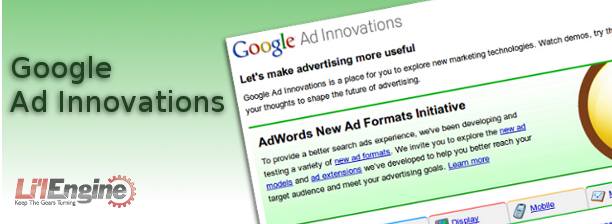
Google Ad Innovations was launched at the end of March as a lab for ad products it is considering. It’s designed to help AdWords account holders experiment with ad technologies and get their feedback about the new products. They may or may not be released for real in the future, depending on how they test out among AdWords users.
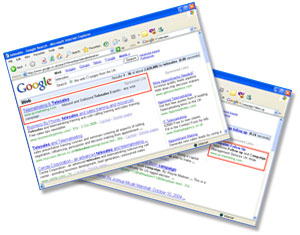 Search Funnels was launched a couple of weeks ago. It slices and dices your search, conversion, keyword, and number of steps preceding conversions so you can figure out which ads are getting the most conversions and why. It’s actually pretty complicated, but there’s a video at the official AdWords Blog that gives you a good overview.
Search Funnels was launched a couple of weeks ago. It slices and dices your search, conversion, keyword, and number of steps preceding conversions so you can figure out which ads are getting the most conversions and why. It’s actually pretty complicated, but there’s a video at the official AdWords Blog that gives you a good overview.
Google has long been known for text-based CPC ads, but have been busy coming up with ad models based on these text ads. The new ad models are product listing ads, comparison ads, and ad extensions, which consist of sitelinks, product extensions, video extensions, location extensions, multiple addresses for location extensions, and click to call phone extensions. Let’s go through each of these.
Product Listing Ads are in limited beta release right now. They include more product info, like images, prices, and merchant names without requiring additional keywords or text. So when someone enters a search query relevant to something in your Google Merchant Center account, Google may or may not show the most relevant products with the associated price, product name, and image. These are only charged on a cost per action (CPA) basis, so you only have to pay when someone actually buys something from your site.
Comparison Ads are also in limited beta release. These let users compare several relevant offers and work on a cost per lead format. With these, the users do not have to fill in forms, and Comparison Ads doesn’t send advertisers any kind of personally identifiable user stats. Right now this is being used for the credit card and mortgage loan industries in select locations. Comparison ads should let advertisers target offers more accurately in order to get more leads.
The suite of Ad Extensions lets users make ads more relevant and more useful. They expand on the concept of standard text ads, letting viewers have the option of getting additional information right in the ad without leaving the search page. These extensions work with existing text ads without requiring changes to bids, ad text, or keywords. Following are the types of Ad Extensions offered.
Ad Sitelinks lets advertisers extend the possibilities for existing AdWords ads, providing links to specific content deeper within your site’s sitemap. So rather than sending all users to the same landing page, Ad Sitelinks will offer up to four more destination URLs for potential customers to choose from. You can use ad sitelinks to direct visitors to specific parts of your site, such as promotions, store locators, and gift registries. Early users have reported improvements in clickthrough rates of up to 30%.
Product Extensions are in limited release and allow you to add more to your existing AdWords ads with specific product information on the merchandise you sell. It uses your existing Google Merchant Center account to highlight products relevant to the user’s query. They can also show pictures, titles, and prices of products. In the first screen shot, you’ll see the “plus box” under the ad indicating the product extension. When a user clicks on that plus box, lots of products, along with thumbnail pictures show up, as you can see in the second screen shot. You’re charged the same CPC whether the user clicks on your main text ad or any offers in the product extensions box. But if a user simply expands the box without clicking through to the site, you’re not charged.

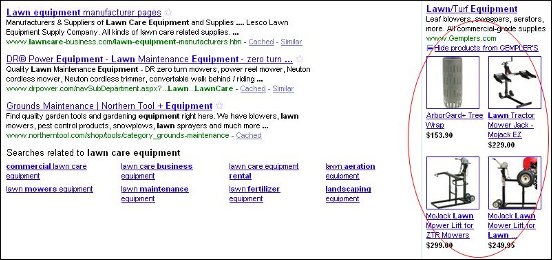
Video Extensions are in limited beta release and allow you to engage prospective customers with video content. The video extensions are in an expandable plus box under the standard text ad. If the user watches the ad for 10 seconds or more, you’re charged based on your maximum cost per click bid of your text ad. After vieing the video, the user can click the URL link in the ad or go directly to your site with no extra charge to you. These are great for movie trailers and product usage instructions.
Location Extensions attach your business address to your ads. Your ad can also contain your business’s name, phone number, and address, promoting your business and its products and services with a specific location that’s of interest to the user. It’s good for drawing in local customers.
Multiple Addresses for Location Extensions, also in limited beta release displays a plus box under ads at the top of the page. Whenever a user clicks on that plus box, he or she sees a map that shows store locations near them, plus a search box for moving the map around. This feature shows as many stores as are relevant to a given search, increasing the chance of picking up local customers.
Click to Call Phone Extensions are for people searching for products and / or services from their smart mobile phone (like the iPhone, Android, or Palm Pre). This feature has been fully released. If someone finds your business on a search and would rather call you than visit your website, they can use a click to call phone extension they’ve found in ads on their mobile devices that have full internet browsing capability. You’re charged the same for a customer’s call as you would had they clicked on your website.

Online public relations campaigns can be used as very effective off-page SEO. Done well, they can increase targeted traffic to your site. A good PR effort for SEO should include keyword optimized press releases to increase the visibility of your brand in the marketplace and get you more leads and sales.
In the best of all worlds, you would use both “push” and “pull” marketing, where you push your message to the media your prospects tend to use most. The pull strategy “pulls” prospects to your site by making your site more visible in media where your prospects already visit. The end result can be more traffic, higher placement on SERPs, more organic, high quality, inbound links to your site, and press releases being picked up by top industry publications.
Even with embedded video, flash, and other non-text content, the internet is still mostly made up of information in text form. Search engines that crawl the web looking for good sites with high quality content are crawling text. They can’t “see” images, so any information they get pertaining to those images have to come from filenames and from the text surrounding the images. Pages without text won’t rank well. Pages that have text have an advantage that depends partly upon how relevant and cohesive it is. The best content, according to the search engine crawlers, is text that is keyword rich (not stuffed), original, and relevant. Using article directories is a strategy to boost the search engine rankings of your website and hence your sales.
Article directories allow anyone to post articles for marketing. The articles have to be informative and can’t just be blatant sales pitches. Most article directories have fairly strict rules on the standards that the articles they publish have to meet. Many times these rules relate to the number of “self-serving” links allowed in the main body of the text, and the information that can be placed in the “resource box” that is placed at the end of each article.
Put simply, article directories are a way to spread the gospel about your website. If you adhere to the rules set forth by an article directory, you’ll have no problem getting your articles accepted. Google likes the major article directories, like Ezinearticles, ArticlesBase,and Goarticles. An article in one or all of these directories can get you some nice back links to your website. In fact, you’ll have a better chance of ranking on the first page of search engine results with articles on one of these sites than if the article was on your own website.
As far as back links go, back links from some article directories are more valuable than back links on others. But since the number of back links your website has is taken into account (as far as we know), then you should benefit from them. The “bad” back links are ones from paid link schemes, link swapping schemes, and from the so-called bad neighborhoods on the net, like porn sites and gambling sites.
While you can access services that submit articles to many directories, this isn’t the best idea. For one thing, duplicate articles all over the place aren’t going to get much love from the search engines (since they like original and not duplicated content). And for another, five high quality articles submitted to five high quality article directories will benefit you more than two dozen crappy articles submitted everywhere in a scatter-shot approach. The top article directories are high traffic sites, and some of that traffic is bound to find your site from your bio or resource box.
Before you write an article for a given directory, go to their submission guidelines and make sure you follow them. Some are more strict than others. Ezinearticles, for example, is very strict about the number of links that can go in articles, how far into the article those links must appear, and whether or not those links appear “self-serving.” (See screen shot of Ezinearticles editorial rules) Other sites, however, like eHow and GoArticles.com are not as picky. But they have their rules too, and you have to follow them.
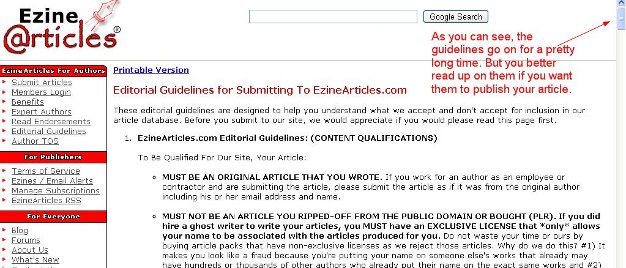
On most sites, you can freely submit articles once you register a free account. You’ll generally be able to add an author byline, a hyperlink, and the address for your website. The better written the article is, the more readers it will attract, and the more potential traffic your website could receive.
After you have your accounts set up, you should do some keyword research to see which keywords you need to target with your articles. If you can write (or have somebody write) several unique articles targeting those keywords, you can potentially draw a lot of attention to your site indirectly. Choose your titles carefully. Sometimes this can be tricky, because you have to worry about duplicate titles, but really give it the thought and attention it deserves. Keywords in your titles are important, just like they are on your website.
While article directories don’t get as much love as they used to from search engines, they still get points for original, keyword relevant content, and the best article directories are still good sources of back links to your site. It is still not unusual for articles from the top article directories to rank on the first page of the search engine results for some topics. It is about as close as your site can get to free advertising, even if you have to hire a writer for the articles.
Create a bio for yourself as the author (even if you outsource the writing, you’re the one who ends up with the copyright). Most article directories allow at least one link to be placed in the “bio” box. Sort out how many self-serving links you get, and then sort out how you want to parcel them out between your website’s home page, other pages on your website, or your blog if you have one.
Link to your article directory submissions from your blog and from social networking sites like Facebook and Twitter. You can also use sites like Digg and StumbleUpon to bring a few more eyeballs to your article.
In conclusion, article directories are another tool in your web promotion toolkit. They are about as close to free advertising as you can get, and if your content is good, you will be rewarded for it with increased traffic to your site.
Update, I have had several requests for a list of article directories, so here is some we use:
http://www.ezinearticles.com
http://www.ehow.com
http://www.ezarticleinformation.com
http://www.articledashboard.com
OK, let’s be honest right off the bat: most press releases received by most media organizations go right into the recycling bin. But that doesn’t mean yours will. For one thing, the good press releases have a few things in common, and for another, “media” now includes bloggers, ezines, streaming content producers, and freelancers. Whoever you plan to send press releases to, do some research on them first and make sure that your press releases would be a good fit for their organization. It’s the 21st century version of the old “don’t send a dog article to a cat magazine” rule.
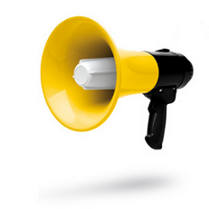 The press release is by no means dead, and is in fact very useful in many situations. Your press releases should be sent to news media for the purpose of letting the world know about company developments and newsworthy items. Concentrate on the word “newsworthy.” The number one reason journalists toss press releases is because they so often consist of self promotion dressed up to appear newsworthy.
The press release is by no means dead, and is in fact very useful in many situations. Your press releases should be sent to news media for the purpose of letting the world know about company developments and newsworthy items. Concentrate on the word “newsworthy.” The number one reason journalists toss press releases is because they so often consist of self promotion dressed up to appear newsworthy.
So really, the first thing you should ask yourself when you’re thinking about sending a press release is “Should I be sending a press release? Or is this just an exercise in vanity or wishful thinking?” Use the “so what” test, because this is what journalists and publishers do. If your press release says, “XYZ Widgetry, Inc. recently hired Dr. Joan Thingity to be head of their engineering development department,” the first thing the journalist is going to think is, you guessed it, “So what?”
Ah, but if your next sentence tells about how she won a MacArthur genius grant for her work on desktop plasma widgetry (or whatever) and that she was at one time part of NASA’s astronaut corps, then you’ve got an answer for the “So what” question. If your press release cannot answer the “So what” question, then don’t send it. Wait until you have something meaty.
While a successful press release ought to be newsworthy, you may have to make the tie-in to the news yourself. Journalists are busy enough that they’re not going to automatically realize that the release of your new phone app coincides with the latest iPhone release. You’ll have to spell it out.
Here are some ways to make sure that your press release is newsworthy and therefore less likely to be chucked in the recycle bin.
You get the idea.
You may wonder why you should bother at all with press releases, since they have such a high chance of disappearing into the gaping maw that is the editor’s office, never to be seen again. But it’s all a part of your overall marketing strategy. SEO has a place, plain old advertising has a place, and media relations has a place too. Once you do get a press release or two picked up, consider contacting the editor or reporters you have traction with and offer to send them exclusives. If they know that they’re the only game in town getting your press releases, they may just take you up on it. But none of this can happen without first mastering the press release. You’ll get nowhere unless you have correct grammar, spelling, and punctuation, plus the compelling writing necessary to stand out from the rest of the herd.

It seems that practically every webmaster understands (or has at least heard) that email marketing is important. The problem is, too many webmasters just stick an email newsletter signup form on their website and figure that they’ve got email marketing taken care of. Nothing could be further from the truth.
An email marketing campaign needs to be carefully planned, setup and optimized for maximum performance. There are many aspects of an email marketing campaign that need your serious attention – opt-ins, messages, deliverability, open rates, etc. This article will just cover one important aspect: email opt-in rate.
In this article, I want to cover three keys to a high opt-in rate that every email marketer should constantly work to improve. (For the purposes of this article, it does not really matter if your campaign is primarily a newsletter or autoresponder.)
The first step to maximize email opt-ins is to offer website visitors a strong value in exchange for subscribing. In most cases, just offering a newsletter is not a strong enough offer – you need something with a much higher perceived value.
One of the best offers is to give a free ebook or whitepaper to subscribers. It does not have to be extensive – oftentimes a 5-10 page ebook that is filled with solid, valuable information will work very well. Make sure that the free gift that you offer subscribers will be appealing and offer value to each segment of traffic that visits your website (or as many of the segments as possible).
An example of a free ebook offer:
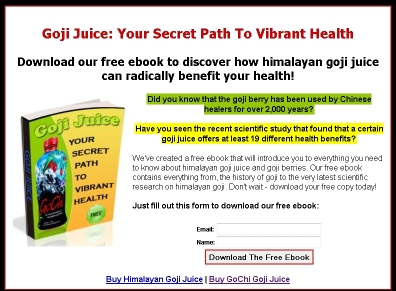
(Note how the free ebook in this case is actually relatively promotional in nature. In small, product-focused niches, this strategy often works well. In other markets, you’ll usually need to offer a more educational ebook.)
The opt-in form on your website should be crafted and optimized to convert as many visitors as possible into subscribers. The form should be:
Example of a poor opt-in form:

Examples of strong opt-in forms:

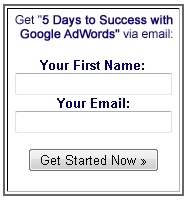
Note: If you aren’t already, you should be requiring subscribers double-opt in. (We’ll just assume that you are for the rest of this article.)
It is essential that you optimize your double opt-in process, since a poorly constructed process can “leak” a substantial number of subscribers. A well-constructed double opt-in process, though, could reasonably get 70-80% of subscribers to complete the opt-in. (While losing 20 to 30% of subscribers may sound bad, realize that a substantial portion of those are probably users who mistyped their email or intentionally submitted an incorrect e-mail.)
Here are several factors you should look at to improve your confirmed opt-in rate:
Summary
Achieving a high email opt-in rate is the starting point for a successful email marketing strategy. Hopefully the tips outlined in this article help you as you continually work to increase your email opt-in rate.
 About The Author
About The Author
Adam J Thompson is Senior Partner at RYP Marketing, providing search engine marketing, conversion rate optimization, and online marketing results to clients around the globe since 2006. You can follow Adam on RYP Marketing’s Facebook page.
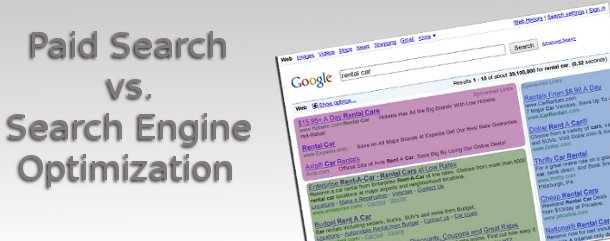
2004 Google Chief Engineer Craig Neville-Manning insisted that Google maintained a strict separation between the search index part of Google and the paid advertising part. Sometimes this separation was referred to as a “Chinese Wall” between organic search engine results and paid search engine results, but this terminology fell out of favor once Google started trying to gain suction in the harshly competitive market in China, and the recent Google in China drama has definitely kept the term buried, but that’s another whole story.
The question is, does Google still live up to this separation between paid and organic results? They insist that Adwords is totally separated from organic search engine placement, that the two are in parallel channels and as such will never meet. What exactly does this mean in practice?
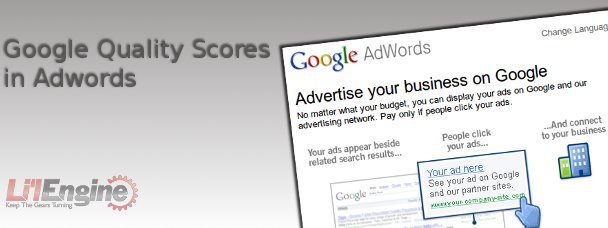
Adwords calculates a Quality Score for every one of your keywords. The Quality Score is a measure of how relevant the keyword is to the text in your ad and users’ search queries. It is determined by a variety of factors. The Quality Score for a given keyword updates frequently to reflect its performance. Generally speaking, the higher the Quality Score, the higher the position at which your keyword activates ads, at a lower CPC (cost per click). Sounds like you want your Quality Scores to be as high as possible, right?

There’s an old adage in international marketing circles that says to go global, businesses really have to think local.
Apple recently launched its ubiquitously popular iPhone in China and after more than two months, it had shifted a mere 5,000 handsets. Whilst it is a product that will be unaffordable to many people in China, in a country of more than one billion people, most conservative forecasts of iPhone’s two-month sales figures prior to launch would be at least fifty times that.
Apple failed to consider a number of factors when launching the iPhone, namely Chinese consumers prefer not to sign long-term contracts, opting for charge cards instead, allowing a greater degree of flexibility for the user. This isn’t the only reason it hasn’t taken off, but it’s a factor that Apple really should have considered prior to launch – they should’ve properly researched the market.
At a micro level, it’s easier than ever for the smallest of home-built businesses to network and trade on the international arena. But the first step towards doing so is to build a fully localized presence in your key target markets– and the process begins with adapting your company website for each country you plan to tap into.
Like Apple should’ve done with the iPhone, you need to fully understand your target country, know what excites them and what, ultimately, is likely to encourage them to part with their hard-earned cash.
 The only way businesses should communicate with their international markets is in the native language of the local consumers. Even though English is the most commonly spoken second language in the world, the fact remains that people prefer to communicate in their mother tongue. Furthermore, three quarters of the world’s population speak no English whatsoever.
The only way businesses should communicate with their international markets is in the native language of the local consumers. Even though English is the most commonly spoken second language in the world, the fact remains that people prefer to communicate in their mother tongue. Furthermore, three quarters of the world’s population speak no English whatsoever.
Contrary to what many people think, fluency in a particular language doesn’t qualify someone to translate into it. To provide convincing translations, the translator requires first-hand knowledge of the culture of that language which is why most translators will only ever work INTO their native tongue from another language in which they are fluent.
Furthermore, many linguists will specialize in a particular subject – such as marketing, engineering or agriculture. If your company’s products or services involve highly technical terminology, you will probably want to consider checking with the translation company that they have suitable candidates with the right level of experience.
The important thing to remember when translating your website or any other marketing material is that what works in one country, might not translate the way you want it to in another. What’s clever and witty in one country, might be offensive in another. This is something only a native-speaking translator will know.
It’s also important to be wary of dialects within languages. If you translate your website into French, it doesn’t mean you can use it for all French-speaking countries.
In France, a ‘post-office box’ is a boîte postale, but in Belgium and Switzerland it’s a case postale. In France, ‘lunch’ is déjeuner, but in Belgium and Switzerland the word for ‘lunch’ is dîner which, incidentally, is the word for ‘evening meal’ in France. There is a whole host of linguistic nuances between the French, German and Portuguese dialects of the world. Even closer to home, the English in the US and the English in the UK are significantly different…not to the point of requiring an entirely different website, but certainly to the point of requiring significant care and attention when writing the English text.
When marketing internationally, the words ‘language’ and ‘local’ should always go hand-in-hand. Failing to do so can lead to a very costly global venture for businesses where funds may be limited.
About the Author
Article by Christian Arno, the Managing Director of Lingo24.
Visit Christian’s website at www.lingo24.com.